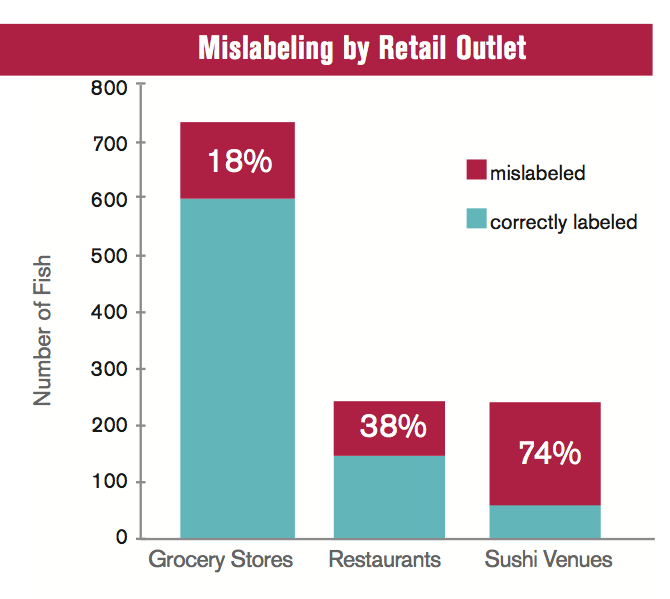If you’re an American who enjoys eating tuna on a regular basis, there’s a very good chance the fish you’ve purchased at some point isn’t actually tuna.
I’ll save your insides the suspense and cut to the chase — Most of it is actually a fish known as escolar.
As to why that is, nonprofit organization Oceana’s executive report explains:
“Some mislabeling may result from human error in identifying fish or their origin. More often, it is driven by economic gain, as when a cheaper or more readily available species is substituted for one that is more expensive, desirable or in limited supply.”
Oceana is the group that originally uncovered this fishy mislabeling by genetically testing 1,215 fish samples from across the U.S. from 2010 to 2012. They found that 59% of the tuna sold in restaurants and grocery stores is actually not tuna. Sushi restaurants were more likely to mislabel their fish than other restaurants.
The graph below, created by Oceana, lays out the numbers.
Sushi from 647 retail outlets across 21 states was studied.
This should really come as no surprise. After all, the tuna population has been known to be on the decline for some time now. And when some restaurants and grocers are still selling fish for prices comparable to what they were decades ago, something’s gotta be up.
Tuna isn’t the only fish Oceana’s study found to be commonly mislabeled. An alarming 87% of fish sold as snapper was also found to be some other type of fish.
How on earth are seafood companies getting away with this?

The answer turns out to be fairly predictable, especially in light of what’s been happening in other industries – a lack of regulation.
Oceana’s report states that only 1% of seafood is actually tested for fraud. Recommendations from the group include increasing regulation:
“Our findings demonstrate that a comprehensive and transparent traceability system — one that tracks fish from boat to plate — must be established at the national level.
At the same time, increased inspection and testing of our seafood, specifically for mislabeling, and stronger federal and state enforcement of existing laws combatting fraud are needed to reverse these disturbing trends.”
That’s Not The Only Reason To Avoid Tuna

A study done by the U.S. Geological Survey found elevated levels of mercury in all tuna they tested. The worst offenders were restaurant tuna.
So How Do You Spot Mislabeled Tuna?

Now that you have all this information, how do you put it to good use to keep yourself safe? Dr. Mercola over at Healthy Holistic Living makes these three recommendations:
- Ask. Before you buy tuna, you should be able to ask where it came from as well as when and how it was bought. If you’re given a hard time when asking, take your business elsewhere.
- Look at the price. If the price is really really really good despite the aforementioned tuna population crisis, it’s probably not real tuna.
- Buy the whole fish. When you can, you’ll want to purchase the whole fish as opposed to split pieces. It’s naturally much harder to misrepresent an entire fish.


